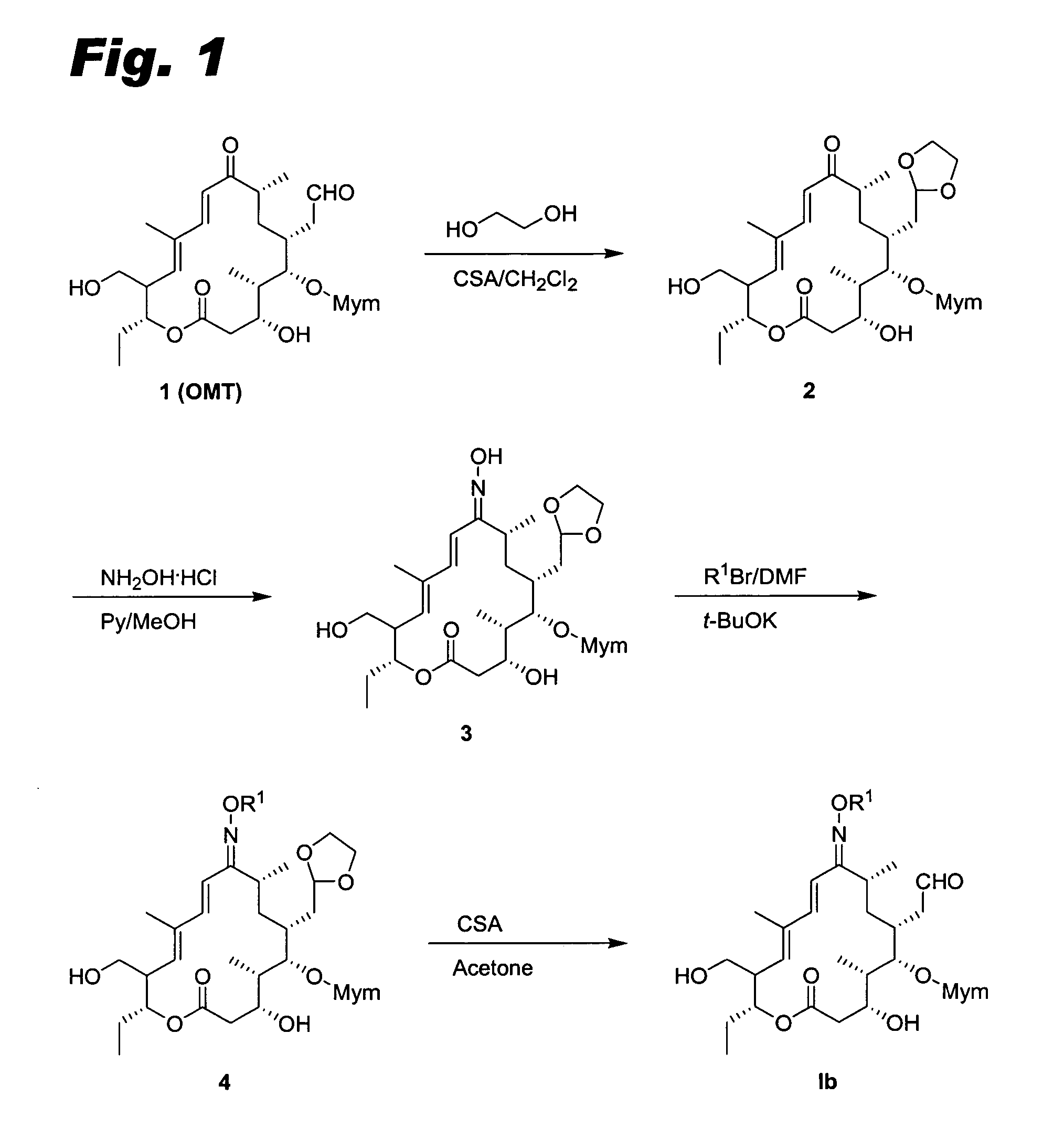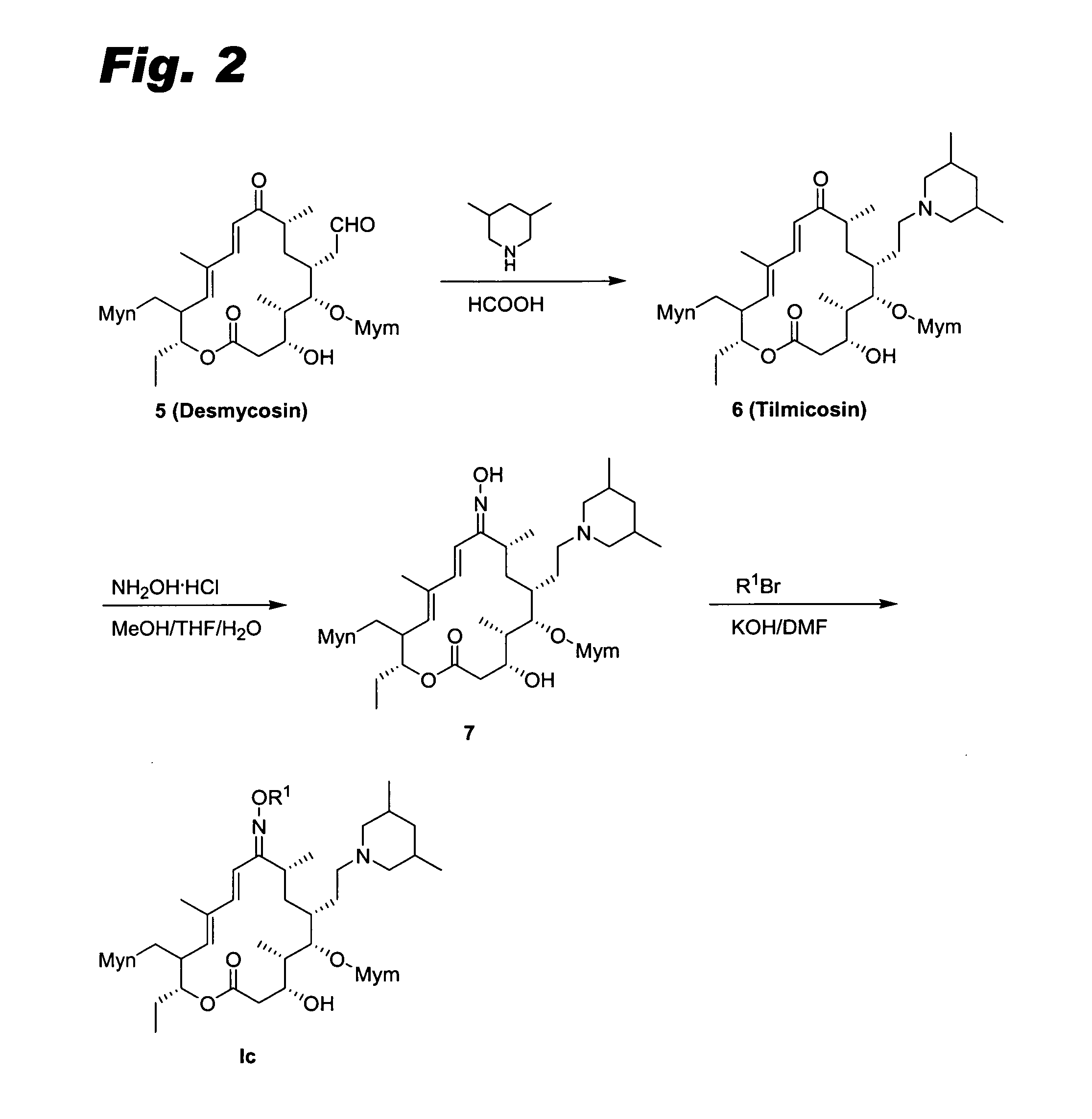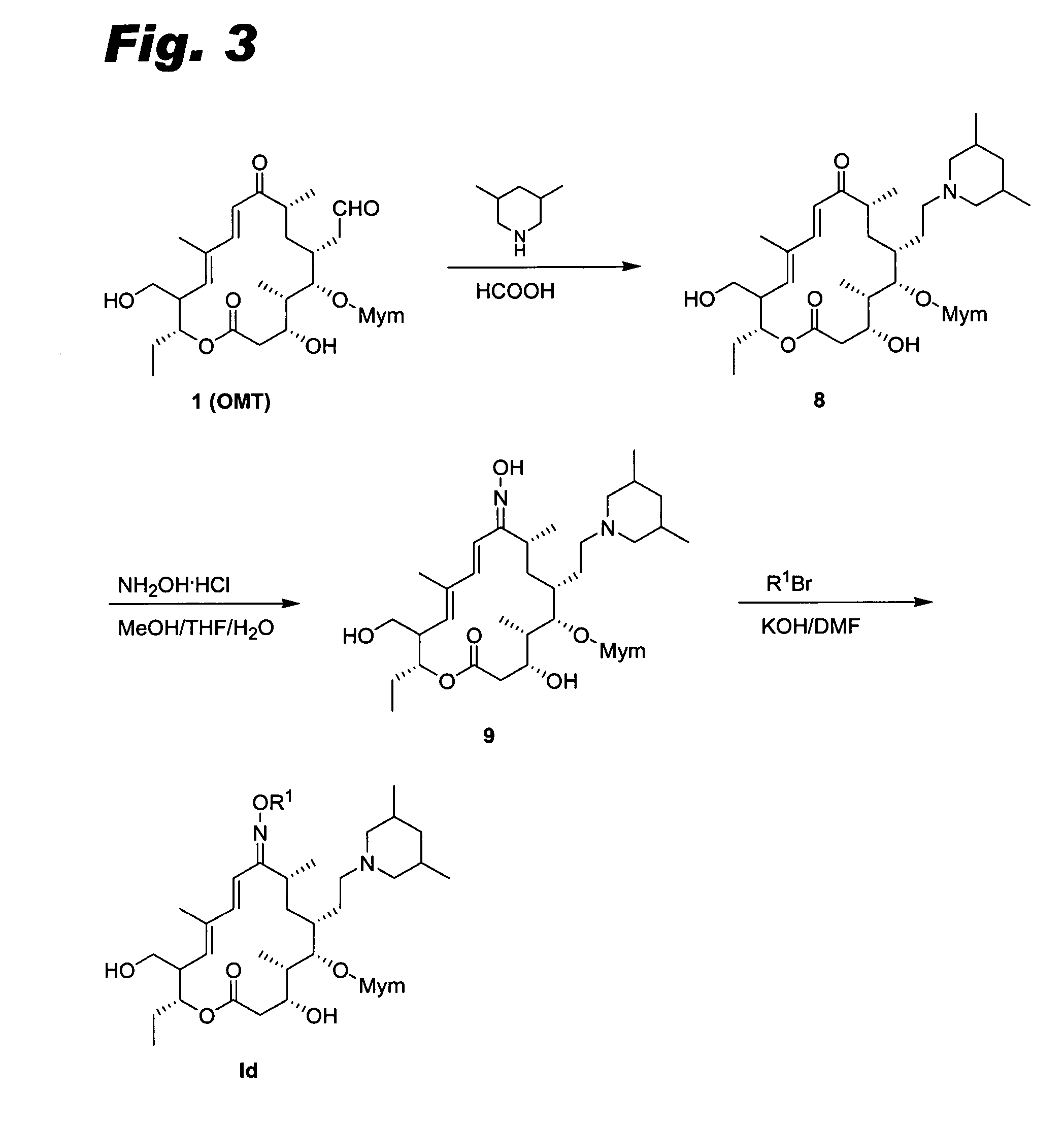Sixteen-member macrolide antiinfective agents
- Summary
- Abstract
- Description
- Claims
- Application Information
AI Technical Summary
Benefits of technology
Problems solved by technology
Method used
Image
Examples
example 2
Compounds Ic
[0101] This example describes the preparation of compounds according to formula Ic, using compounds K and L as the archetypes and following the scheme in FIG. 2.
[0102] Step 1: Tilmicosin 9-oxime 7. Tilmicosin (6, 0.5754 mmol; Debono et al., J. Antibiot. 42 (8), 1253-1267 (1989), incorporated herein by reference) was dissolved in MeOH (24 mL), THF (6 mL), and H2O (2 mL). NH2OH.HCl (0.8 g, 11.5 mmol) was added. The reaction mixture was heated to 50° C. for 5 hr. The MeOH and THF were removed under reduced pressure. EtOAc (200 mL) was added. The organic phase was washed with saturated NaHCO3 (3×100 mL), dried over Na2SO4, filtered, and evaporated to dryness to give tilmiconsin 9-oxime 7 (234 mg) as a mixture of E and Z isomer, which was used in the next step without purification.
[0103] Step 2: Compounds K and L. To a solution of tilmicosin 9-oxime 7 (60 mg, 0.06787 mmol) in DMF (0.5 mL) was added 6-(3-bromo-propoxy)quinoline (2.4 eq) and KOH (85% powder, 2.4 eq). The rea...
example 3
Compounds Id
[0113] Compounds Id were prepared as shown in FIG. 3. The procedures were analogous to those used for compounds Ic, except that OMT 1 was used instead of tilmicosin 6. See Debono et al., J. Antibiot. 42 (8), 1253-1267 (1989). The E and Z isomers were separated, except where noted otherwise.
[0114] Compound R. 1H NMR (400 MHz, CDCl3) δ (ppm) 8.76 (d, J=2.8 Hz, 2H), 8.03 (d, J=8.0 Hz,1H), 8.00 (d, J=9.2 Hz, 1H), 7.35 (m, 2H), 7.08 (d, J=2 Hz, 1H), 6.71 (d, J=16.8 Hz, 1H), 6.61 (d, J=16.8, 1H), 5.57 (d, J=10.4 Hz, 1H), 4.77 (m, 1H), 2.79 (s, 6H), 1.78 (s, 3H), LC-MS (m / z) calculated for C50H78N4O10 894.57; found 896.0 (M+1).
[0115] Compound S. 1H NMR (400 MHz, CDCl3) δ (ppm), 8.77 (br, 1H), 8.01 (d, J=9.2 Hz, 1H), 8.00 (d, J=8.0 Hz, 1H), 7.37 (d, J=5.6 Hz, 1H), 7.36 (d, J=6.4 Hz, 1H), 7.05 (d, J=2.4 Hz, 1H), 6.68 (d, J=16.8 Hz, 1H), 6.07 (d, J=17.2 Hz, 1H), 5.46 (d, J=10.8 Hz, 1H), 4.82 (dd, J=11.2 Hz, 11.2 Hz, 1H), 1.22 (d, J=7.2 Hz, 3H), 1.04 (d, J=6.4 Hz, 3H), 0.97 (t, ...
example 4
Compounds Ie
[0121] Compounds Ie were prepared according to FIG. 4, with the following procedure for converting compound A to compounds Y and Z being representative.
[0122] Step 1: Phosphate ester 10. Compound A (218 mg, 0.26 mmol, 1 eq) was flushed under N2 for 30 min. Freshly distilled THF (0.5 mL) was added followed by 1,8-diazabicyclo[5.4.0]undec-7-ene (“DBU,” 38.7 μL, 1 eq), and diphenylphosphorylazide (61.5 μL, 1.1 eq). The reaction mixture was stirred at RT for 2 hr. TLC (10% MeOH in CH2Cl2) indicated the starting material was consumed and a new upper spot appeared. Solvent was removed under vacuum. Separation of the product using silica gel column on ISCO (1% Et3N in CH2Cl2 to 1% Et3N to 1% MeOH in CH2Cl2) to yield 173 mg of phosphate ester 10.
[0123] Step 2: 23-Azido Compound 11. Phosphate ester 10 (173 mg, 1 eq) was dissolved in DMF (3.2 mL). NaN3 (314 mg, 30 eq) was added. The reaction mixture was heated to 50° C. The reaction progress was monitored by HPLC (C-18 reverse ...
PUM
| Property | Measurement | Unit |
|---|---|---|
| structure | aaaaa | aaaaa |
| affinity | aaaaa | aaaaa |
| chemically stable | aaaaa | aaaaa |
Abstract
Description
Claims
Application Information
 Login to View More
Login to View More - R&D
- Intellectual Property
- Life Sciences
- Materials
- Tech Scout
- Unparalleled Data Quality
- Higher Quality Content
- 60% Fewer Hallucinations
Browse by: Latest US Patents, China's latest patents, Technical Efficacy Thesaurus, Application Domain, Technology Topic, Popular Technical Reports.
© 2025 PatSnap. All rights reserved.Legal|Privacy policy|Modern Slavery Act Transparency Statement|Sitemap|About US| Contact US: help@patsnap.com



